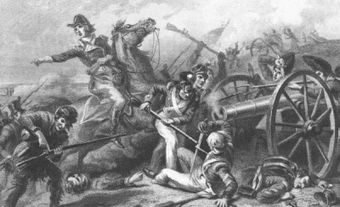Fort Mississauga National Historic Site of Canada
Fort Mississauga National Historic Site, located in NIAGARA-ON-THE-LAKE, Ont, was designated as a national historic site in 1931 by the Historic Sites and Monuments Board of Canada. The British built Fort Mississauga between 1813 and 1823 to guard the mouth of the NIAGARA RIVER. While not completed until after the WAR OF 1812, it did see action during that conflict.
The original earthworks, impressive stone and brick tower, powder magazines and sally port are preserved by Parks Canada. A golf course surrounds the site but the grounds are accessible. The tower is only open by arrangement. Exterior displays and a viewpoint on the earthworks provide a good understanding of the strategic nature of the fort.
Fort's History
Mississauga Point is located at the mouth of the Niagara River, and across the river from the American FORT NIAGARA. From a strategic standpoint, it was an ideal location in times of war for preventing enemy shipping from entering the river. The British erected the first LIGHTHOUSE on the Great Lakes here in 1804 and constructed a small gun battery nearby for defensive purposes.
When the Americans declared war on the British on 18 June 1812, the British underestimated the threat and did little to strengthen their defences in Niagara (now Niagara-on-the-Lake). An American invasion, repulsed at the BATTLE OF QUEENSTON HEIGHTS, forced the British to strengthen the position at Mississauga Point. The work had yet to be undertaken when a large American army launched a successful amphibious invasion of Niagara on 27 May 1813. During the BATTLE OF FORT GEORGE, artillery at Mississauga Point fired only one shot before it was disabled. The Americans occupied Fort George and Niagara for the next 7 months, finally being forced out on 10 December. On the American retreat, the town was burned.
The British reoccupied Niagara on 11 December and captured Fort Niagara 8 days later. They planned to strengthen Fort George, keep a strong force at Fort Niagara and build a new fort at Mississauga Point to counteract Fort Niagara and to guard the mouth of the river. When the frost left the ground in March 1814, they began work on a star-shaped earthen fort with deep palisade-lined ditches and batteries of heavy artillery. They also began work on a stone and brick tower, 2 brick gunpowder magazines, wooden barracks and other buildings. The lighthouse was demolished and building materials from this structure and what could be salvaged from the destroyed town were used in the construction of the tower.
In July 1814, the Americans invaded again, taking FORT ERIE and defeating a British army at the BATTLE OF CHIPPAWA. On 15 July, a large American force reconnoitred British positions at Niagara and planned to attack Forts George and Mississauga. The British became aware of American movements in the woods outside of the town and fired artillery from Fort Mississauga , apparently causing no casualties. A supporting American fleet failed to arrive as expected and the Americans retreated to Fort Erie.
Niagara was not seriously threatened for the rest of the war. Construction of Fort Mississauga continued and it replaced Fort George as the main defensive facility in Niagara. It was completed by 1823, but only sporadically garrisoned for the next 40 years.
During the FENIAN uprisings (1865-66), it was occupied by militia but was considered obsolete by that time and was little used until being abandoned in 1867. During World War I, the golf course (built in 1875) was closed and the CANADIAN EXPEDITIONARY FORCE used the grounds for training.

 Share on Facebook
Share on Facebook Share on X
Share on X Share by Email
Share by Email Share on Google Classroom
Share on Google Classroom


